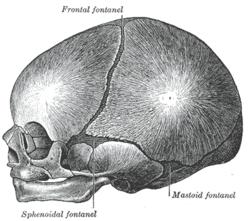Skull of a newborn
The skull of a newborn, in contrast to the skull of an adult, shows various differences. These are mainly in size and shape, which disappear in the course of development. It is very fragile immediately after birth, for which reason it must be handled with great care.
The dimensions[edit | edit source]
The skull of a newborn measures 11.1 cm anteroposteriorly, to which should be added approximately 4 mm of soft tissue.The greatest width between the temporal bones is 9 cm. The circumference of the newborn's head is 34 cm.[1]
Characteristic features[edit | edit source]
The skull of a newborn differs from a fully developed adult skull in many growth and shape features.
The neonatal skull is elongated anteroposteriorly and is pentagonal in shape from above (due to the predominance of ossification centres = the thickest parts of the bones). These ossification centres are the tubera frontalia and tubera parietalia. The main differences include the disproportionately large neurocranium compared to the splanchnocranium, which is small and low - this is due to the shape of the maxilla, nasal cavity and septum. The sinuses are not developed; they occur only in a hint as niches.
Another feature for the neonatal skull is the paired os frontale, which is divided in the middle by a suture. In rare cases, it may persist into adulthood as a sutura metopica. Differences are also seen on the hard palate, where sutures are present between the os incisivum (praemaxilla) and the maxillae. The mandible and ramus mandibulae are low. In the middle of the chin there is a ligamentous symphysis (symphysis menti) which connects the left and right halves of the mandible. This ligamentous connection disappears by the end of the first year of life.
Fontanelles[edit | edit source]
Between the bones of the cranial vault are ligamentous bands. For this reason, the bones of the cranial vault are slightly mobile and their edges are tucked under each other during birth (the so-called head configuration for easier passage through the birth canal). In some places, these connective bands develop into larger connective membranes called fontanelles.
- Fonticulus anterior (major)
- At the junction of the frontal, coronal and sagittal sutures. It has a four-pointed rhombic (rhombic) shape, the longer end of which is directed towards the frontal suture. It disappears by the end of the 2nd year.
- Fonticulus posterior (minor)
- A three-pointed suture occurring posteriorly, at the junction of the sagittal and lambda sutures. It usually disappears within three months after birth. In some newborns it is no longer visible.
Fonticulus anterior and fonticulus posterior are palpable and allow the obstetrician to orient the position of the head during labour.
- Fonticulus sphenoidalis
- At the point of convergence of the large wings of the cuneiform bone with the frontal, parietal and temporal bones. The shape is irregularly quadrangular.
- Fonticulus mastoideus
- Further posteriorly between the processus mastoideus, the occipital bone and the posterior inferior tip of the parietal bone.
Fonticulus sphenoidalis and fonticulus mastoideus are impalpable because they are covered by soft tissues.
Non-constant formations[edit | edit source]
There may invariably be fontanelles other than those mentioned above.
- Fonticulus metopicus – in the frontal suture;
- fonticulus parietalis – in the sagittal suture.
Separate ossification centres may also appear inside the flakes, which give rise to separate ossicles.
- Os bregmaticum – in the fonticulus anterior;
- os epiptericum – in the fonticulus sphenoidalis, over the great wing of the sphenoidale.
Sources[edit | edit source]
Related articles[edit | edit source]
Used literature[edit | edit source]
- PETROVICKÝ, Pavel. Anatomie s topografií a klinickými aplikacemi I. : Pohybové ústrojí. 1. edition. Vydavateľstvo Osvěta, 2001. 463 pp. ISBN 80-8063-046-1.
- ČIHÁK, Radomír. Anatomie 1. 3. edition. Grada Publishing, a.s., 2011. 552 pp. vol. 1. ISBN 978-8-247-3817-8.
References[edit | edit source]
- ↑ ČIHÁK, Radomír. Anatomie 1. 3. edition. Grada, 2011. 552 pp. ISBN 978-80-247-3817-8.



